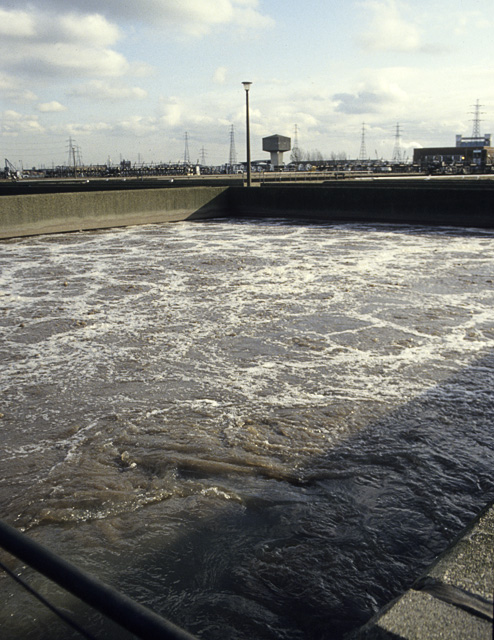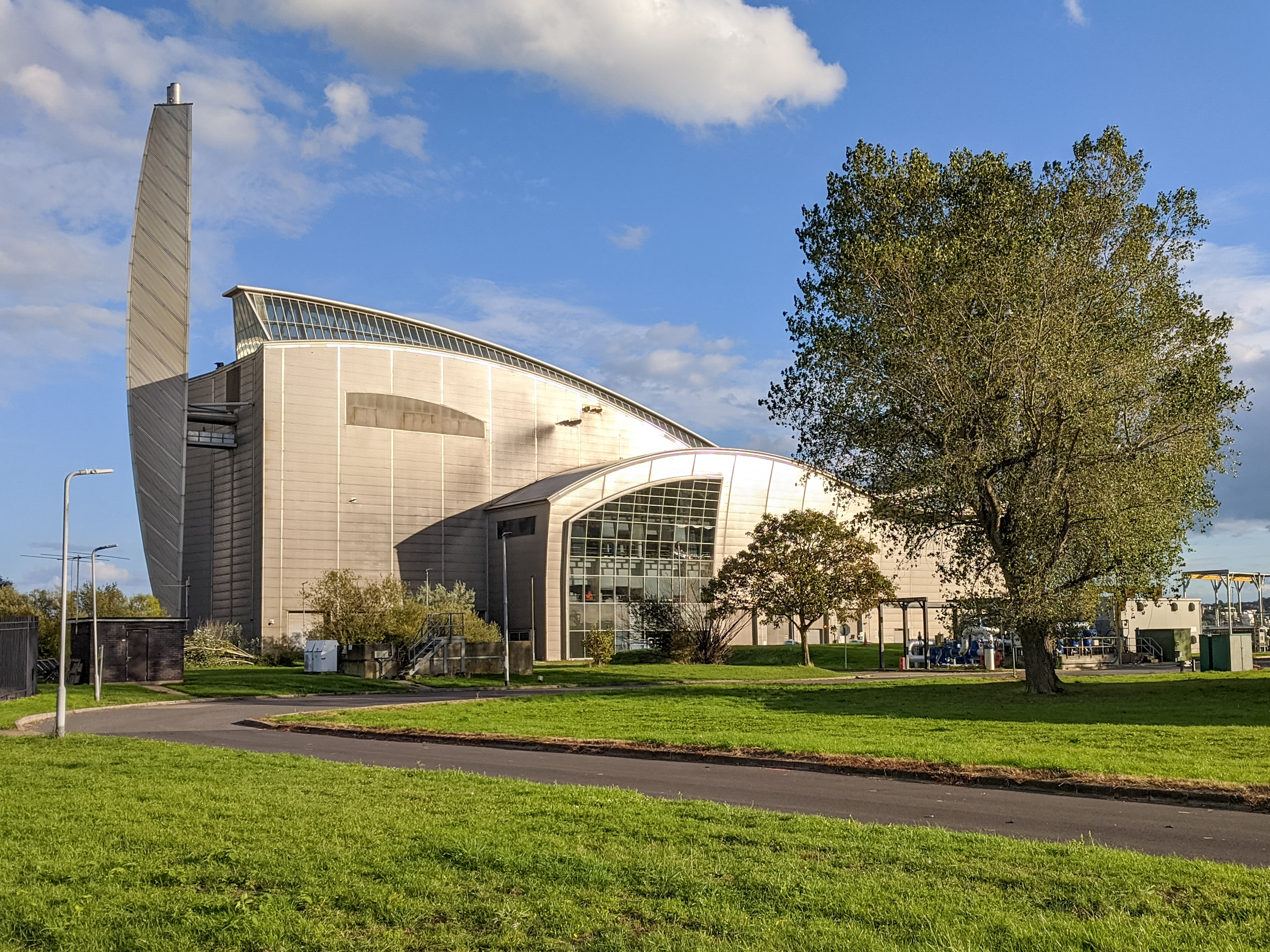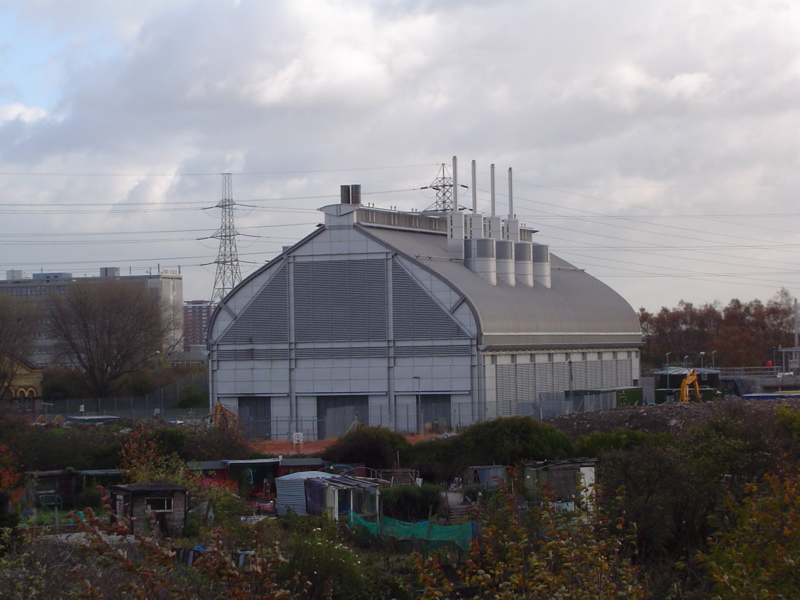|
Beckton Sewage Treatment Works
Beckton Sewage Treatment Works, formerly known as Barking Sewage Works, is a large sewage treatment plant in Beckton in the east London Borough of Newham, operated by Thames Water. Since construction first began in 1864, the plant has been extended numerous times and now covers over 100 hectares (250 acres) - the largest sewage treatment works in Europe. It treats waste water arriving from the Northern Outfall Sewer and the Lee Tunnel, serving a large portion of London north of the River Thames. The treated effluent from the plant is discharged into the Thames at the south-east corner of the site, adjacent to Barking Creek. History Sewage treatment works were first established at Beckton in 1864 as part of Joseph Bazalgette's scheme to remove sewage (and hence reduce disease) from London by creating two large sewers from the capital, one on each side of the Thames and known as the Southern and Northern Outfall Sewers. In addition to the sewage from the Northern Outfall sewer ... [...More Info...] [...Related Items...] OR: [Wikipedia] [Google] [Baidu] |
Beckton STP, Activated Sludge Tank - Geograph
Beckton is a suburb in east London, England, located east of Charing Cross and part of the London Borough of Newham. Adjacent to the River Thames, the area consisted of unpopulated marshland known as the East Ham Levels in the parishes of Barking, East Ham, West Ham and Woolwich. The development of major industrial infrastructure in the 19th century to support the growing metropolis of London caused an increase in population with housing built in the area for workers of the Beckton Gas Works and Beckton Sewage Treatment Works. The area has a convoluted local government history and has formed part of Greater London since 1965. Between 1981 and 1995 it was within the London Docklands Development Corporation area, which caused the population to increase as new homes were built and the Docklands Light Railway was constructed. History Toponymy Beckton is named after Simon Adams Beck, the governor of the Gas Light and Coke Company when work building Beckton Gas Works began in Nov ... [...More Info...] [...Related Items...] OR: [Wikipedia] [Google] [Baidu] |
Iron Sulfate
Iron sulfate may refer to: * Ferrous sulfate, Iron(II) sulfate Iron(II) sulfate (British English: iron(II) sulphate) or ferrous sulfate denotes a range of salts with the formula Fe SO4·''x''H2O. These compounds exist most commonly as the heptahydrate (''x'' = 7) but several values for x are know ..., FeSO4 * Ferric sulfate, Iron(III) sulfate, Fe2(SO4)3 {{Short pages monitor ... [...More Info...] [...Related Items...] OR: [Wikipedia] [Google] [Baidu] |
Crossness Sewage Treatment Works
The Crossness Sewage Treatment Works is a sewage treatment plant located at Crossness in the London Borough of Greenwich. It was opened in 1865 and is Europe's second largest sewage treatment works, after its counterpart Beckton Sewage Treatment Works located north of the river. Crossness treats the waste water from the Southern Outfall Sewer serving South and South East London, and is operated by Thames Water. The treated effluent from the plant is discharged into the River Thames at the eastern end of the site. History As originally conceived the works comprised reservoirs covering 2.6 hectares designed to retain six hours’ flow of sewage. No sewage treatment was provided and the sewage was discharged untreated into the River Thames on the ebb tide. Following the ''Princess Alice'' disaster in 1878 a Royal Commission was appointed in 1882 to examine Metropolitan Sewage Disposal. It recommended that a precipitation process should be deployed to separate solids from the liq ... [...More Info...] [...Related Items...] OR: [Wikipedia] [Google] [Baidu] |
London Sewer System
The London sewer system is part of the water infrastructure serving London, England. The modern system was developed during the late 19th century, and as London has grown the system has been expanded. It is currently owned and operated by Thames Water and serves almost all of Greater London. History During the early 19th century the River Thames was an open sewer, with disastrous consequences for public health in London, including cholera epidemics. These were caused by enterotoxin-producing strains of the bacterium ''Vibrio cholerae''. Although the contamination of the water supply was correctly diagnosed by Dr John Snow in 1849 as the method of communication, up to the outbreak of 1866 it was believed that miasma, or bad air, was responsible. Proposals to modernise the sewerage system had been made in the early 1700s but the costs of such a project deterred progress. Further proposals followed in 1856, but were again neglected due to the costs. However, after the Great Stink ... [...More Info...] [...Related Items...] OR: [Wikipedia] [Google] [Baidu] |
Reverse Osmosis
Reverse osmosis (RO) is a water purification process that uses a partially permeable membrane to separate ions, unwanted molecules and larger particles from drinking water. In reverse osmosis, an applied pressure is used to overcome osmotic pressure, a colligative property that is driven by chemical potential differences of the solvent, a thermodynamic parameter. Reverse osmosis can remove many types of dissolved and suspended chemical species as well as biological ones (principally bacteria) from water, and is used in both industrial processes and the production of potable water. The result is that the solute is retained on the pressurized side of the membrane and the pure solvent is allowed to pass to the other side. To be "selective", this membrane should not allow large molecules or ions through the pores (holes), but should allow smaller components of the solution (such as solvent molecules, e.g., water, H2O) to pass freely. In the normal osmosis process, the solvent ... [...More Info...] [...Related Items...] OR: [Wikipedia] [Google] [Baidu] |
Brackish
Brackish water, sometimes termed brack water, is water occurring in a natural environment that has more salinity than freshwater, but not as much as seawater. It may result from mixing seawater (salt water) and fresh water together, as in estuaries, or it may occur in brackish fossil aquifers. The word comes from the Middle Dutch root '' brak''. Certain human activities can produce brackish water, in particular civil engineering projects such as dikes and the flooding of coastal marshland to produce brackish water pools for freshwater prawn farming. Brackish water is also the primary waste product of the salinity gradient power process. Because brackish water is hostile to the growth of most terrestrial plant species, without appropriate management it is damaging to the environment (see article on shrimp farms). Technically, brackish water contains between 0.5 and 30 grams of salt per litre—more often expressed as 0.5 to 30 parts per thousand (‰), which is a speci ... [...More Info...] [...Related Items...] OR: [Wikipedia] [Google] [Baidu] |
Boris Johnson
Alexander Boris de Pfeffel Johnson (; born 19 June 1964) is a British politician, writer and journalist who served as Prime Minister of the United Kingdom and Leader of the Conservative Party from 2019 to 2022. He previously served as Foreign Secretary from 2016 to 2018 and as Mayor of London from 2008 to 2016. Johnson has been Member of Parliament (MP) for Uxbridge and South Ruislip since 2015, having previously been MP for Henley from 2001 to 2008. Johnson attended Eton College, and studied Classics at Balliol College, Oxford. He was elected president of the Oxford Union in 1986. In 1989, he became the Brussels correspondent — and later political columnist — for '' The Daily Telegraph'', and from 1999 to 2005 was the editor of ''The Spectator''. Following his election to parliament in 2001 he was a shadow minister under Conservative leaders Michael Howard and David Cameron. In 2008, Johnson was elected mayor of London and resigned from the House of Common ... [...More Info...] [...Related Items...] OR: [Wikipedia] [Google] [Baidu] |
Ken Livingstone
Kenneth Robert Livingstone (born 17 June 1945) is an English politician who served as the Leader of the Greater London Council (GLC) from 1981 until the council was abolished in 1986, and as Mayor of London from the creation of the office in 2000 until 2008. He also served as the Member of Parliament (MP) for Brent East from 1987 to 2001. A former member of the Labour Party, he was on the party's hard left, ideologically identifying as a socialist. Born in Lambeth, South London, to a working-class family, Livingstone joined Labour in 1968 and was elected to represent Norwood at the GLC in 1973, Hackney North and Stoke Newington in 1977, and Paddington in 1981. That year, Labour representatives on the GLC elected him as the council's leader. Attempting to reduce London Underground fares, his plans were challenged in court and declared unlawful; more successful were his schemes to benefit women and several minority groups, despite stiff opposition. The mainstream ... [...More Info...] [...Related Items...] OR: [Wikipedia] [Google] [Baidu] |
Desalination
Desalination is a process that takes away mineral components from saline water. More generally, desalination refers to the removal of salts and minerals from a target substance, as in soil desalination, which is an issue for agriculture. Saltwater (especially sea water) is desalinated to produce water suitable for human consumption or irrigation. The by-product of the desalination process is brine. Desalination is used on many seagoing ships and submarines. Most of the modern interest in desalination is focused on cost-effective provision of fresh water for human use. Along with recycled wastewater, it is one of the few rainfall-independent water resources. Due to its energy consumption, desalinating sea water is generally more costly than fresh water from surface water or groundwater, water recycling and water conservation. However, these alternatives are not always available and depletion of reserves is a critical problem worldwide. Desalination processes are using eith ... [...More Info...] [...Related Items...] OR: [Wikipedia] [Google] [Baidu] |
Abbey Mills Pumping Station
Abbey Mills Pumping Station is a sewage pumping station in Mill Meads, East London, operated by Thames Water. The pumping station lifts sewage from the London sewerage system into the Northern Outfall Sewer and the Lee Tunnel, which both run to Beckton Sewage Treatment Works. The original pumping station, designed by engineer Joseph Bazalgette, Edmund Cooper, and architect Charles Driver, was built between 1865 and 1868, housing eight beam engines by Rothwell & Co. of Bolton. Two engines on each arm of a cruciform plan, with an elaborate Byzantine style, described as ''The Cathedral of Sewage''. Another of Bazalgette's designs, Crossness Pumping Station, is located south of the River Thames at Crossness, at the end of the Southern Outfall Sewer. A modern sewage pumping station (Station F) was completed in 1997 about south of the original station. History The pumping station was built at the site of an earlier watermill owned by the former Stratford Langthorne Abbey, from w ... [...More Info...] [...Related Items...] OR: [Wikipedia] [Google] [Baidu] |
Sewage Sludge
Sewage sludge is the residual, semi-solid material that is produced as a by-product during sewage treatment of industrial or municipal wastewater. The term " septage" also refers to sludge from simple wastewater treatment but is connected to simple on-site sanitation systems, such as septic tanks. When fresh sewage or wastewater enters a primary settling tank, approximately 50% of the suspended solid matter will settle out in an hour and a half. This collection of solids is known as raw sludge or primary solids and is said to be "fresh" before anaerobic processes become active. The sludge will become putrescent in a short time once anaerobic bacteria take over, and must be removed from the sedimentation tank before this happens. This is accomplished in one of two ways. Most commonly, the fresh sludge is continuously extracted from the bottom of a hopper-shaped tank by mechanical scrapers and passed to separate sludge-digestion tanks. In some treatment plants an Imhoff tan ... [...More Info...] [...Related Items...] OR: [Wikipedia] [Google] [Baidu] |
Activated Sludge
The activated sludge process is a type of biological wastewater treatment process for treating sewage or industrial wastewaters using aeration and a biological floc composed of bacteria and protozoa. It uses air (or oxygen) and microorganisms to biologically oxidize organic pollutants, producing a waste sludge (or floc) containing the oxidized material. The activated sludge process for removing carbonaceous pollution begins with an aeration tank where air (or oxygen) is injected into the waste water. This is followed by a settling tank to allow the biological flocs (the sludge blanket) to settle, thus separating the biological sludge from the clear treated water. Part of the waste sludge is recycled to the aeration tank and the remaining waste sludge is removed for further treatment and ultimate disposal. Plant types include package plants, oxidation ditch, deep shaft/vertical treatment, surface-aerated basins, sequencing batch reactors (SBRs). Aeration methods include dif ... [...More Info...] [...Related Items...] OR: [Wikipedia] [Google] [Baidu] |









.jpg)